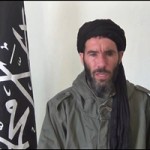For several weeks there has been rumbling of al Qaeda in the Islamic Maghreb (AQIM) fragmenting in the Sahel. This morning, All Africa reports:
Former Al-Qaeda in the Islamic Maghreb (AQIM) emir Mokhtar Belmokhtar (aka “Laaouar”) quit the group to assemble his own band of suicide bombers in northern Mali. …The Algerian terrorist (real name Khaled Abou El Abass) reportedly left AQIM after his demotion as head of the El Moulethemine katibat (“Brigade of the Veiled Ones”)
It appears Belmokhtar wants to create his own terrorist group, which I imagine will compete with AQIM for recruits, turf, weapons and money.
The new terrorist group “is headquartered in the Malian city of Gao, which is under the control of Islamists from the Movement for Tawhid and Jihad in West Africa (MUJAO), an offshoot of AQIM”….Through the creation of the new group, Belmokhtar wants “to help to consolidate Sharia rule in northern Mali, where armed Islamists are enforcing Islamic law very strictly after having driven the Malian army out in the spring,” the French daily added… Belmokhtar will finance his activities “including the purchase of weapons” by “specialising in the kidnapping of Westerners, whom he usually frees in return for large ransoms”.
So why would Mokhtar, a long-time leader of AQIM, break from the group that according to ‘Western analysts’ is becoming so strong? Much of the recent counterterrorism analysis I have read suggests that ransoms from kidnappings, foreign fighters moving to the Sahel, weapons from Libya’s collapse has all led to unity and strength in AQIM. But is that the case, the All Africa article suggests something different.
“One of the reasons for this dissent is the disagreement between these leaders over how to share the ransoms paid for the release of Western hostages,” said Abdalahi Ould Ahmed, editor-in-chief of the daily newspaper Chouhoud….”As the organisation has grown and incorporated fighters of different origins, conflicts of interests have become increasingly frequent,” he added….Journalist Hamid Fekhart argued that “Droukdel’s decision was motivated by the unruliness of his junior, who is thought to have been gunning for him over the past few months. Security sources say that the supreme leader, who tried in vain to bring Mokhtar Belmokhtar to heel, simply decided to relieve him of his duties as part of a bid to reorganise AQIM.”…Fekhart noted that his successor, thirty-six year old Abou El Hammam, was reportedly “behind the kidnapping of an Italian-Burkina Faso couple in the Sahel in December 2010″.
Well, it looks like more money and fighters has led to more conflict than unity in AQIM. Analysis suggesting more of any one terror group input (Weapons, money, fighters, etc) will lead directly to a stronger collective whole (AQIM) naively ignores the one thing that is most difficult to quantify and analyze: Human nature.
Concurrent to recent discussions of the rise of Shabaab (February-ish 2012), AQAP in Yemen (May-ish 2012) and then AQIM (Summer-ish 2012) has been the notion that al Qaeda’s ideology continues unabated, stronger than ever, and remains a binding tie that overides petty disputes within the terror group over leadership and resources. GARBAGE! Ideology and money go hand-in-hand for al Qaeda. Money without ideology turns AQ affiliates into little more than organized criminal groups. Ideology without money, over time, renders al Qaeda nothing more than a poorly resourced cult drowned out by better financed Muslim Brotherhood affiliated organizations. As Gregory Johnsen noted in his book on AQAP, what separated Bin Laden and al Qaeda from other militant groups was that:
“Bin Laden talked less than others, but he planned more. And he had something no one else had: money.”
In June, I argued that the al Qaeda of 9/11/2001 really does not exist today. One of the reasons I pushed this theory arises from the new state of acquisition and allocation of resources amongst al Qaeda affiliates. Across al Qaeda’s global footprint, decentralization has led to there being more incentive for affiliates to compete than cooperate. With Bin Laden’s death, donors spread their funds more diffusely and local affiliate illicit revenue schemes must increase. Ultimately, this change leads to al Qaeda affiliates with waning allegiance to al Qaeda Central. As I noted in July,
As money transfers shift, influence, authority and strategic direction will drift.
For counterterrorists, Belmokhtar’s defection will hopefully prove to be instructive. How do we replicate the conditions that led to Belmokhtar’s creation of a competing terror group? In some cases, infrequent but well calculated drone strikes on key AQ leaders, I believe, can be very effective. However, I think in the end it might be subtle, indirect actions that help exploit these factors. What if the French or Germans were to only pay kidnapping ransoms to one leader of AQIM as opposed to another? Could we use the unfortunate action of having to pay ransoms as a method/opportunity for creating dissension in the ranks of a loosely formed al Qaeda coalition? Maybe.



